Incorporate Kettlebells
If you want to switch up your strength training or if you haven’t yet found muscle-strengthening activities you enjoy, find the kettlebells at your gym or health club! Kettlebell exercises are straightforward and faster to learn than many other resistance training techniques. Since a kettlebell’s center of mass is off-center, it offers a unique challenge compared to other types of free weights like dumbbells.
The kettlebell is a cannonball-shaped ball of iron with a handle on top that has roots back to the 18th century. First used as a counterweight for weighing crops, people soon realized its potential for building strength, balance, flexibility, and endurance. In the late 19th century, it gained a spot in strength recreation and competition. Today, the versatile kettlebell makes for efficient strength workouts at the gym and at home.
Strengthening exercises can be accomplished with lots of activities, like yoga or gardening, but kettlebell exercises keep things efficient and practical since they’re compound movements. Compound means that you need to recruit multiple muscle groups at the same time to accomplish a move. Compound movements help establish greater coordination between your brain and muscles in different parts of your body. Increased involvement of stabilizing muscles during compound exercises develops better control in your joints making falls, injuries, and dislocations less likely in the real world. As a bonus, compound exercises burn lots of calories since you need to fire-up many different muscles to complete a movement. It’s estimated that vigorous-intensity kettlebell workouts can burn up to 20 calories per minute, the equivalent of running a six-minute mile!
No matter how you do it, aim to do muscle-strengthening activities that work your back, chest, arms, shoulders, trunk, and legs at least twice each week. Kettlebells might not be the way to go if you’re brand new to strength training. So, if you’re not there yet, take your time and gradually work towards meeting muscle-strengthening guidelines with bodyweight exercises like push-ups, lunges, and squats.
The exercises below mimic motions we use in everyday life, like sitting down, standing up, bending over, and walking with heavy loads of groceries. These functional exercises help reduce the risk of injury and make activities of everyday life more comfortable. The best part? You can do them with dumbbells too! Check with your doctor to make sure you’re in good health to begin an exercise program.
Kettlebell Goblet Squat
Muscles engaged: Lower body and core
Functional purpose: Teaches proper form for crouching down and picking something up.
Once you’ve mastered the bodyweight version, make them more challenging by adding resistance with a kettlebell held close to your chest.
- Stand with your feet about shoulder-width apart with your toes turned out slightly but in-line with your knees.
- Grip the sides of a kettlebell with your hands and hold firmly in front of your chest.
- Keep your elbows close to your rib cage and lower into a squat. Keep lowering until your hips are below your knees.
- Push your feet through the floor and return to the starting position.
Kettlebell Deadlifts
Muscles engaged: Lower body, back, and core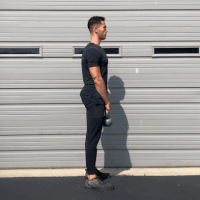
Functional purpose: Develops the muscles needed to lift heavy objects, like a table, and carry groceries or a bucket of water.
Do it with dumbbells by holding one in each hand.
- Stand with your feet hip-width apart and knees slightly bent. Keep toes in-line with your knees.
- Bring a kettlebell in front of your thighs with both hands on the handle, palms facing towards you. Keep your arms straight for the entirety of the movement.
- Hinge at your hips and push your glutes back as you lower your torso and the kettlebell to the ground.
- Keep your back flat and shoulders back. Lower until you feel a stretch in your hamstrings and glutes.
- When your torso is nearly parallel to the ground, squeeze your core and push through your heels to stand up straight.
- Pause in the standing position and squeeze your glutes.
Lunges
Muscles engaged: Primarily lower body but core and back too.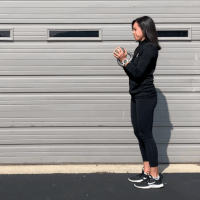
Functional purpose: Mimics walking and stair-climbing.
Master bodyweight alternating lunges or walking lunges first, then add weight.
- Grasp the base of a kettlebell with both hands and hold it against your chest.
- Take a big step forward and lower your torso towards the ground until both knees reach about 90 degrees. Avoid bending forward at the hips. Your back should be straight, shoulders back, chest up, and core tight.
- Push through your heels and return to the starting position.
Bent-over rows
Muscles engaged: Primarily back but triceps, core, and chest too.
Functional purpose: Teaches you how to safely bend over and pick up something heavy.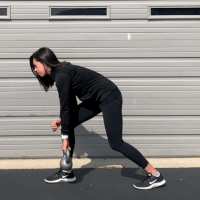
- Place your left leg out a few feet in front of your right, so you’re in a lunge position.
- Keep your back flat and hinge forward at your hips. Rest your left forearm on your left thigh.
- With your right arm hanging straight at your side, grasp the handle of a kettlebell in your right hand. Double-check that your hips and shoulders are square with the floor.
- Raise the kettlebell to your ribcage in a slow and controlled manner until your elbow points towards the sky. Lower the kettlebell, then repeat. Protect your neck by keeping your eyes downward.
Triceps presses
Muscles engaged: Arms
Functional purpose: Strengthening the triceps tendon will help with motions that involve pushing with your arms.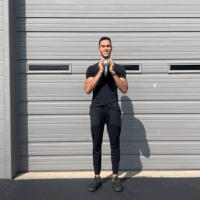
- From a standing position, hold the ball-shaped part of a kettlebell at the base of its handle.
- Raise the kettlebell overhead and lower it behind your head until neck level. Raise the kettlebell overhead by straightening your arms.
- Keep your elbows close to your ears throughout the exercise and avoid arching your back—think about tucking your pelvis under so you don’t strain your lower back.
Farmer’s Carry
Muscles engaged: Trapezius (upper back), shoulders, lower body, and core.
Functional purpose: Mimics carrying a heavy suitcase or a large load of groceries. Develops grip strength to help you hold onto heavy objects for longer.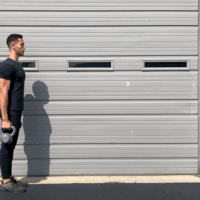
- Hold two kettlebells firmly by their handles at your sides. Keep them from touching your legs by holding them a couple of inches away from your body.
- Look straight ahead and start walking slowly with small steps. Keep your shoulder blades back and core tight. Don’t let the weight pull your shoulders down. Avoid looking down and rounding your back.
